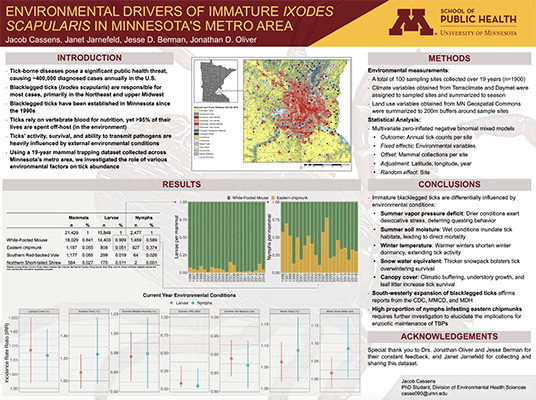Jacob Cassens
PhD, Environmental Health
Co-Authors:
Janet Jarnefeld, Jesse D. Berman, Jonathan D. Oliver
Advisor:
Jonathan D. Oliver
Keywords:
Ticks; environment
Abstract
Research on the public health significance of Ixodes scapularis ticks in the Midwest seldomly focus on the habitat-specific abiotic characteristics that can modulate population dynamics and their ability to transmit pathogenic organisms. In this study, we assessed whether the distributional abundance of I. scapularis immatures is associated with current and time-lagged climatic determinants either directly or indirectly. We analyzed a 20-year longitudinal small mammal live-trapping dataset within a seven-county metropolitan area in Minnesota (1998-2016), estimated yearly abundances at each site, and asked whether inter- and intra-annual variation in immature I. scapularis abundances are associated with five climatic variables selected a priori. We found that (1) immature I. scapularis ticks infesting mammals expanded south-westerly over the study period, (2) eastern chipmunks supplied a substantial proportion of nymphal blood meals, (3) a suite of climatological variables are demonstrably associated with blacklegged tick presence and abundance across sites, notably average maximum summer temperatures and relative humidity, and (4) immature blacklegged ticks display an affinity for deciduous forests. Our results suggest that climatic and land-type conditions may impact host-seeking I. scapularis ticks through numerous mechanistic avenues. These findings extend our understanding of the suitable climatic envelope permitting blacklegged tick expansion in the Upper Midwest with strong implications for predicting future tick-borne pathogen risk.

View Poster (PDF)
